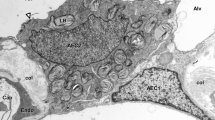Abstract
Detailed investigations on the microstructure and the mechanical properties of the wing membrane of the dragonfly are carried out. It is found that in the direction of the thickness the membrane was divided into three layers rather than a single entity as traditionally considered, and on the surfaces the membrane displays a random distribution rough microstructure that is composed of numerous nanometer scale columns coated by the cuticle wax secreted. The characteristics of the surface structure are measured and described. The mechanical properties of the membranes taken separately from the wings of live and dead dragonflies are investigated by the nanoindentation technique. The Young’s moduli obtained here are approximately two times greater than the previous result, and the reasons that yield the difference are discussed.
Similar content being viewed by others
References
Dalton S. (1975). Borne on the wind: the extraordinary world of insects in flight. Reader’s Digest Press, New York
Wootton R.J. (1990). The mechanical design of insect wings. Sci. Am. 11: 114–120
Wootton R.J. (1992). Functional morphology of insect wings. Annu. Rev. Entomol. 37: 113–140
Smith C.W., Herbert R., Wootton R.J. and Evans K.E. (2000). The hind wing of the desert locust (Schistocerca gregaria Forskål). II. Mechanical properties and functioning of the membrane. J. Exp. Biol. 203: 2933–2943
Combes S.A. and Daniel T.L. (2003). Flexural stiffness in insect wings I. Scaling and the influence of wing venation. J. Exp. Biol. 206: 2979–2987
Ho S., Nassaf H., Pornsin-Sirirak N., Tai Y.C. and Ho C.M. (2002). Flight dynamics of small vehicles. In: Grant, I. (eds) Proceedings of the international council of the aeronautical sciences (ICAS), pp 551.1–551.10. ICAS, Toronto
Fearing, R.S., Chiang, K.H., Dickinson, M.H., Pick, D.L., Sitti, M., Yan, J.: Wing transmission of a micromechanical flying insect. In: Alessandro D.L. (ed.) Proceedings of the 2000, IEEE. international conference on robotics and automation, pp. 1509–1516, Wiley, San Francisco, CA, New Jersey (2000)
Newman D.J.S. and Wootton R.J. (1986). An approach to the mechanics of pleating in dragonfly wings. J. Exp. Biol. 125: 361–372
Kreuz, P., Kesel, B., Arnold, W., Vehoff, H., Nachtigall, W.: Strukter-und materialanalyse biologischer systeme-die Flugelkutikula der insekten (Odonata, Anisoptera). In: Nachtigall W., Wisser A. (eds.) Biona-Report 14, pp. 16–17, Fischer, Stuttgart (2000)
Oliver W.C. and Pharr G.M. (1992). An improved technique for determining hardness and elastic-modulus using load and displacement sensing indentation experiments. J. Mater. Res. 7: 1564–1583
Morgen S.E., Misra R. and Jones P. (2006). Nanomechanical and surface frictional characteristics of a copolymer based on benzoyl-1, 4-phenylene and 1, 3-phenylene. Polymer 47: 2865–2873
Song F., Lee K.L., Soh A.K., Zhu F. and Bai Y.L. (2004). Experimental studies of the material properties of the forewing of cicada (Homóptera, Cicàdidae). J. Exp. Biol. 207: 3035–3042
Joslin D.L. and Oliver W.C. (1990). A new method for analyzing data from continuous depth-sensing microindentation tests. J. Mater. Res. 5: 123–126
Saha R. and Nix W.D. (2002). Effects of the substrate on the determination of thin film mechanical properties by nanoindentation. Acta Mater. 50: 23–38
Zhang T.H. and Huan Y. (2004). Substrate effects on the micro/nanomechanical properties of TiN costings. Tribol. Lett. 17: 911–916
Zhang T.H. and Huan Y. (2005). Nanoindentation and nanoscrach behaviors of DLC coatings on different steel substrates. Composites Sci. Technol. 65: 1409–1413
Gosline J.M. (1988). The elastic properties of rubber-like proteins and highly extensile tissues. In: Vincent, J.F.V. and Currey, J.D. (eds) The Mechanical Properties of Biological Materials, pp 331–358. Cambridge University Press, Cambridge
Author information
Authors and Affiliations
Corresponding author
Additional information
The project supported by the National Natural Science Foundation of China (10372102 and 10672164).
Rights and permissions
About this article
Cite this article
Xiao, K., Bai, K., Wang, W. et al. Experimental study on the microstructure and nanomechanical properties of the wing membrane of dragonfly. Acta Mech Sin 23, 281–285 (2007). https://doi.org/10.1007/s10409-007-0070-9
Received:
Accepted:
Published:
Issue Date:
DOI: https://doi.org/10.1007/s10409-007-0070-9




